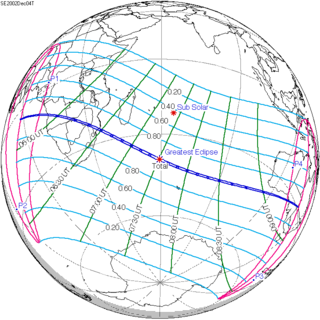Solar eclipse of December 4, 2002
| Solar eclipse of December 4, 2002 | |
|---|---|
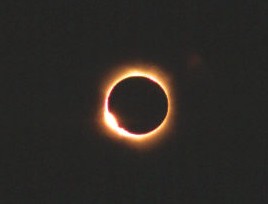 The diamond ring effect at the end of totality, taken near Woomera, South Australia | |
| Type of eclipse | |
| Nature | Total |
| Gamma | −0.302 |
| Magnitude | 1.0244 |
| Maximum eclipse | |
| Duration | 124 s (2 min 4 s) |
| Coordinates | 39°30′S 59°36′E / 39.5°S 59.6°E |
| Max. width of band | 87 km (54 mi) |
| Times (UTC) | |
| Greatest eclipse | 7:32:16 |
| References | |
| Saros | 142 (22 of 72) |
| Catalog # (SE5000) | 9514 |
A total solar eclipse occurred at the Moon's descending node of orbit on Wednesday, December 4, 2002,[1][2][3] with a magnitude of 1.0244. A solar eclipse occurs when the Moon passes between Earth and the Sun, thereby totally or partly obscuring the image of the Sun for a viewer on Earth. A total solar eclipse occurs when the Moon's apparent diameter is larger than the Sun's, blocking all direct sunlight, turning day into darkness. Totality occurs in a narrow path across Earth's surface, with the partial solar eclipse visible over a surrounding region thousands of kilometres wide. Occurring about 1.9 days after perigee (on December 2, 2002, at 8:50 UTC), the Moon's apparent diameter was larger.[4]
The eclipse was visible from a narrow corridor in parts of Angola, Botswana, Zimbabwe, South Africa, Mozambique, the Indian Ocean and South Australia. A partial eclipse was seen from the much broader path of the Moon's penumbra, including most of Africa and Australia in addition to parts of Indonesia and Antarctica. During the sunset after the eclipse many observers in Australia saw numerous and unusual forms of a green flash.[5]
In some parts of Angola, it was the second total eclipse of the Sun within 18 months, following the solar eclipse of June 21, 2001.
Observations
[edit]The Chinese Academy of Sciences sent a team to Australia, to study the gravity anomalies[6] first recorded by Indian scientists during the total solar eclipse of October 24, 1995.[7] The Chinese Academy of Sciences also studied it during previous total solar eclipses of March 9, 1997 in Mohe County and June 21, 2001 in Zambia. With continuous observation for more than 10 years after that, China obtained the first observational evidence that the gravity field propagates at the speed of light.[8]
Images
[edit]Gallery
[edit]-
Via eclipse glasses in Ceduna, South Australia
Eclipse details
[edit]Shown below are two tables displaying details about this particular solar eclipse. The first table outlines times at which the moon's penumbra or umbra attains the specific parameter, and the second table describes various other parameters pertaining to this eclipse.[9]
| Event | Time (UTC) |
|---|---|
| First Penumbral External Contact | 2002 December 04 at 04:52:27.3 UTC |
| First Umbral External Contact | 2002 December 04 at 05:51:24.0 UTC |
| First Central Line | 2002 December 04 at 05:51:38.6 UTC |
| First Umbral Internal Contact | 2002 December 04 at 05:51:53.2 UTC |
| First Penumbral Internal Contact | 2002 December 04 at 06:56:18.4 UTC |
| Greatest Eclipse | 2002 December 04 at 07:32:15.7 UTC |
| Greatest Duration | 2002 December 04 at 07:33:01.0 UTC |
| Ecliptic Conjunction | 2002 December 04 at 07:35:26.3 UTC |
| Equatorial Conjunction | 2002 December 04 at 07:39:48.9 UTC |
| Last Penumbral Internal Contact | 2002 December 04 at 08:08:01.3 UTC |
| Last Umbral Internal Contact | 2002 December 04 at 09:12:35.9 UTC |
| Last Central Line | 2002 December 04 at 09:12:48.5 UTC |
| Last Umbral External Contact | 2002 December 04 at 09:13:01.0 UTC |
| Last Penumbral External Contact | 2002 December 04 at 10:12:05.5 UTC |
| Parameter | Value |
|---|---|
| Eclipse Magnitude | 1.02437 |
| Eclipse Obscuration | 1.04934 |
| Gamma | −0.30204 |
| Sun Right Ascension | 16h41m50.9s |
| Sun Declination | -22°13'29.2" |
| Sun Semi-Diameter | 16'13.6" |
| Sun Equatorial Horizontal Parallax | 08.9" |
| Moon Right Ascension | 16h41m32.9s |
| Moon Declination | -22°31'05.2" |
| Moon Semi-Diameter | 16'21.5" |
| Moon Equatorial Horizontal Parallax | 1°00'02.3" |
| ΔT | 64.4 s |
Eclipse season
[edit]This eclipse is part of an eclipse season, a period, roughly every six months, when eclipses occur. Only two (or occasionally three) eclipse seasons occur each year, and each season lasts about 35 days and repeats just short of six months (173 days) later; thus two full eclipse seasons always occur each year. Either two or three eclipses happen each eclipse season. In the sequence below, each eclipse is separated by a fortnight.
| November 20 Ascending node (full moon) |
December 4 Descending node (new moon) |
|---|---|
 |

|
| Penumbral lunar eclipse Lunar Saros 116 |
Total solar eclipse Solar Saros 142 |
Related eclipses
[edit]Eclipses in 2002
[edit]- A penumbral lunar eclipse on May 26.
- An annular solar eclipse on June 10.
- A penumbral lunar eclipse on June 24.
- A penumbral lunar eclipse on November 20.
- A total solar eclipse on December 4.
Metonic
[edit]- Preceded by: Solar eclipse of February 16, 1999
- Followed by: Solar eclipse of September 22, 2006
Tzolkinex
[edit]- Preceded by: Solar eclipse of October 24, 1995
- Followed by: Solar eclipse of January 15, 2010
Half-Saros
[edit]- Preceded by: Lunar eclipse of November 29, 1993
- Followed by: Lunar eclipse of December 10, 2011
Tritos
[edit]- Preceded by: Solar eclipse of January 4, 1992
- Followed by: Solar eclipse of November 3, 2013
Solar Saros 142
[edit]- Preceded by: Solar eclipse of November 22, 1984
- Followed by: Solar eclipse of December 14, 2020
Inex
[edit]- Preceded by: Solar eclipse of December 24, 1973
- Followed by: Solar eclipse of November 14, 2031
Triad
[edit]- Preceded by: Solar eclipse of February 3, 1916
- Followed by: Solar eclipse of October 4, 2089
Solar eclipses of 2000–2003
[edit]This eclipse is a member of a semester series. An eclipse in a semester series of solar eclipses repeats approximately every 177 days and 4 hours (a semester) at alternating nodes of the Moon's orbit.[10]
The partial solar eclipses on February 5, 2000 and July 31, 2000 occur in the previous lunar year eclipse set.
| Solar eclipse series sets from 2000 to 2003 | ||||||
|---|---|---|---|---|---|---|
| Ascending node | Descending node | |||||
| Saros | Map | Gamma | Saros | Map | Gamma | |
| 117 | July 1, 2000 Partial |
−1.28214 | 122 Partial projection in Minneapolis, MN, USA |
December 25, 2000 Partial |
1.13669 | |
127 Totality in Lusaka, Zambia |
June 21, 2001 Total |
−0.57013 | 132 Partial in Minneapolis, MN, USA |
December 14, 2001 Annular |
0.40885 | |
137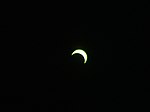 Partial in Los Angeles, CA, USA |
June 10, 2002 Annular |
0.19933 | 142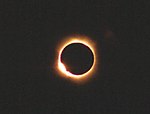 Totality in Woomera, South Australia |
December 4, 2002 Total |
−0.30204 | |
147 Annularity in Culloden, Scotland |
May 31, 2003 Annular |
0.99598 | 152
|
November 23, 2003 Total |
−0.96381 | |
Saros 142
[edit]This eclipse is a part of Saros series 142, repeating every 18 years, 11 days, and containing 72 events. The series started with a partial solar eclipse on April 17, 1624. It contains a hybrid eclipse on July 14, 1768, and total eclipses from July 25, 1786 through October 29, 2543. There are no annular eclipses in this set. The series ends at member 72 as a partial eclipse on June 5, 2904. Its eclipses are tabulated in three columns; every third eclipse in the same column is one exeligmos apart, so they all cast shadows over approximately the same parts of the Earth.
The longest duration of totality will be produced by member 38 at 6 minutes, 34 seconds on May 28, 2291. All eclipses in this series occur at the Moon’s descending node of orbit.[11]
| Series members 11–32 occur between 1801 and 2200: | ||
|---|---|---|
| 11 | 12 | 13 |
 August 5, 1804 |
 August 16, 1822 |
 August 27, 1840 |
| 14 | 15 | 16 |
 September 7, 1858 |
 September 17, 1876 |
 September 29, 1894 |
| 17 | 18 | 19 |
 October 10, 1912 |
 October 21, 1930 |
 November 1, 1948 |
| 20 | 21 | 22 |
 November 12, 1966 |
 November 22, 1984 |
 December 4, 2002 |
| 23 | 24 | 25 |
 December 14, 2020 |
 December 26, 2038 |
 January 5, 2057 |
| 26 | 27 | 28 |
 January 16, 2075 |
 January 27, 2093 |
 February 8, 2111 |
| 29 | 30 | 31 |
 February 18, 2129 |
 March 2, 2147 |
 March 12, 2165 |
| 32 | ||
 March 23, 2183 | ||
Metonic series
[edit]The metonic series repeats eclipses every 19 years (6939.69 days), lasting about 5 cycles. Eclipses occur in nearly the same calendar date. In addition, the octon subseries repeats 1/5 of that or every 3.8 years (1387.94 days). All eclipses in this table occur at the Moon's descending node.
| 21 eclipse events between July 11, 1953 and July 11, 2029 | ||||
|---|---|---|---|---|
| July 10–11 | April 29–30 | February 15–16 | December 4 | September 21–23 |
| 116 | 118 | 120 | 122 | 124 |
 July 11, 1953 |
 April 30, 1957 |
 February 15, 1961 |
 December 4, 1964 |
 September 22, 1968 |
| 126 | 128 | 130 | 132 | 134 |
 July 10, 1972 |
 April 29, 1976 |
 February 16, 1980 |
 December 4, 1983 |
 September 23, 1987 |
| 136 | 138 | 140 | 142 | 144 |
 July 11, 1991 |
 April 29, 1995 |
 February 16, 1999 |
 December 4, 2002 |
 September 22, 2006 |
| 146 | 148 | 150 | 152 | 154 |
 July 11, 2010 |
 April 29, 2014 |
 February 15, 2018 |
 December 4, 2021 |
 September 21, 2025 |
| 156 | ||||
 July 11, 2029 | ||||
Tritos series
[edit]This eclipse is a part of a tritos cycle, repeating at alternating nodes every 135 synodic months (≈ 3986.63 days, or 11 years minus 1 month). Their appearance and longitude are irregular due to a lack of synchronization with the anomalistic month (period of perigee), but groupings of 3 tritos cycles (≈ 33 years minus 3 months) come close (≈ 434.044 anomalistic months), so eclipses are similar in these groupings.
| Series members between 1801 and 2200 | ||||
|---|---|---|---|---|
 June 16, 1806 (Saros 124) |
 May 16, 1817 (Saros 125) |
 April 14, 1828 (Saros 126) |
 March 15, 1839 (Saros 127) |
 February 12, 1850 (Saros 128) |
 January 11, 1861 (Saros 129) |
 December 12, 1871 (Saros 130) |
 November 10, 1882 (Saros 131) |
 October 9, 1893 (Saros 132) |
 September 9, 1904 (Saros 133) |
 August 10, 1915 (Saros 134) |
 July 9, 1926 (Saros 135) |
 June 8, 1937 (Saros 136) |
 May 9, 1948 (Saros 137) |
 April 8, 1959 (Saros 138) |
 March 7, 1970 (Saros 139) |
 February 4, 1981 (Saros 140) |
 January 4, 1992 (Saros 141) |
 December 4, 2002 (Saros 142) |
 November 3, 2013 (Saros 143) |
 October 2, 2024 (Saros 144) |
 September 2, 2035 (Saros 145) |
 August 2, 2046 (Saros 146) |
 July 1, 2057 (Saros 147) |
 May 31, 2068 (Saros 148) |
 May 1, 2079 (Saros 149) |
 March 31, 2090 (Saros 150) |
 February 28, 2101 (Saros 151) |
 January 29, 2112 (Saros 152) |
 December 28, 2122 (Saros 153) |
 November 26, 2133 (Saros 154) |
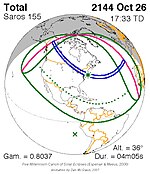 October 26, 2144 (Saros 155) |
 September 26, 2155 (Saros 156) |
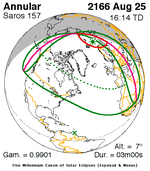 August 25, 2166 (Saros 157) |
 July 25, 2177 (Saros 158) |
 June 24, 2188 (Saros 159) |
 May 24, 2199 (Saros 160) | |||
Inex series
[edit]This eclipse is a part of the long period inex cycle, repeating at alternating nodes, every 358 synodic months (≈ 10,571.95 days, or 29 years minus 20 days). Their appearance and longitude are irregular due to a lack of synchronization with the anomalistic month (period of perigee). However, groupings of 3 inex cycles (≈ 87 years minus 2 months) comes close (≈ 1,151.02 anomalistic months), so eclipses are similar in these groupings.
| Series members between 1801 and 2200 | ||
|---|---|---|
 April 3, 1829 (Saros 136) |
 March 15, 1858 (Saros 137) |
 February 22, 1887 (Saros 138) |
 February 3, 1916 (Saros 139) |
 January 14, 1945 (Saros 140) |
 December 24, 1973 (Saros 141) |
 December 4, 2002 (Saros 142) |
 November 14, 2031 (Saros 143) |
 October 24, 2060 (Saros 144) |
 October 4, 2089 (Saros 145) |
 September 15, 2118 (Saros 146) |
 August 26, 2147 (Saros 147) |
 August 4, 2176 (Saros 148) |
||
Notes
[edit]- ^ "December 4, 2002 Total Solar Eclipse". timeanddate. Retrieved 11 August 2024.
- ^ "Total solar eclipse 'magnificent'". News-Press. 2002-12-05. p. 3. Retrieved 2023-10-25 – via Newspapers.com.
- ^ "Solar eclipse bedazzles southern Africa crowds". News and Record. 2002-12-05. p. 9. Retrieved 2023-10-25 – via Newspapers.com.
- ^ "Moon Distances for London, United Kingdom, England". timeanddate. Retrieved 11 August 2024.
- ^ Maunder, Michael (2007). Lights in the Sky: Identifying and Understanding Astronomical and Meteorological Phenomena. Springer. p. 116. ISBN 978-1846287619. Retrieved 28 September 2013.
- ^ Xue Hui (5 December 2002). "今澳洲可观测到日全食 中国科学家捕捉"微重力"". Beijing Morning Post (in Chinese). Xinhua News Agency. Archived from the original on 25 December 2002.
- ^ Chai Shikuan, Xiong Sihao (25 June 2001). "中科院日全食观测队获得高质量观测数据" (in Chinese). Xinhua News Agency. Archived from the original on 2003-11-03.
- ^ Sun Zifa (26 December 2012). "中国科学家全球首获引力场以光速传播的观测证据" (in Chinese). China News Service. Archived from the original on 24 September 2015.
- ^ "Total Solar Eclipse of 2002 Dec 04". EclipseWise.com. Retrieved 11 August 2024.
- ^ van Gent, R.H. "Solar- and Lunar-Eclipse Predictions from Antiquity to the Present". A Catalogue of Eclipse Cycles. Utrecht University. Retrieved 6 October 2018.
- ^ "NASA - Catalog of Solar Eclipses of Saros 142". eclipse.gsfc.nasa.gov.
References
[edit]- Fred Espenak and Jay Anderson. "Total Solar Eclipse of 2002 December 4". NASA, November 2004.
- Earth visibility chart and eclipse statistics Eclipse Predictions by Fred Espenak, NASA/GSFC
- Google Map
Photos:
- Spaceweather.com: Dec. 4, 2002, Solar Eclipse Gallery and [1]
- Prof. Druckmüller's eclipse photography site. Australia
- Prof. Druckmüller's eclipse photography site. South Africa and Mozambique
- KryssTal - Eclipse from Botswana.
- Images from Australia by Crayford Manor House Astronomical Society Archived 2013-02-09 at archive.today
- Total Solar Eclipse of 4 December 2002 seen in EUMETSAT satellite imagery Archived 6 February 2012 at the Wayback Machine.
- Zimbabwe Solar Eclipse, APOD 12/6/2002, Corona from Zimbabwe-South Africa border
- The Crown of the Sun, APOD 12/13/2002, Corona of total eclipse from Musina, South Africa
- Shadow Cone of a Total Solar Eclipse, APOD 1/6/2003, totality from South Australia

